close-enough broccoli-chickpea salad
+ how to simplify a recipe (unlocked for all subscribers)
knew what every one of us would think when we saw Thomas Keller’s Curried Cauliflower-Chickpea Salad in her newsletter .“NOTE: If you’re wavering on making this salad because it seems like too much work, I assure you it’s worth it.”
I don’t doubt that Thomas Keller’s 30-ingredient, 15-step, 24-hour salad is worth it. But if you want to eat it soon, like tonight, a faster albeit inferior version is better than no salad at all.
Weeknight cooking isn’t about perfection and exactitude. It’s about fulfilling cravings in a way that doesn’t topple your day and spirit. For me, that means making what I feel like eating by manipulating ingredients I already have in an enjoyable, maybe even graceful, process.
taught us how to figure out what you to eat here, so I thought I’d use Keller’s recipe to show how to tailor recipes to your needs. On paper, this exercise appears almost more involved than just following the original recipe, but hopefully outlining my scratchy mental math will provide some steps for people who find “riffing” and “throwing it together” amorphous and scary.Is Keller’s original recipe worth it? I won’t make it so I’ll never know. But here’s how to get close enough. (Or hop-skip to the recipe.)
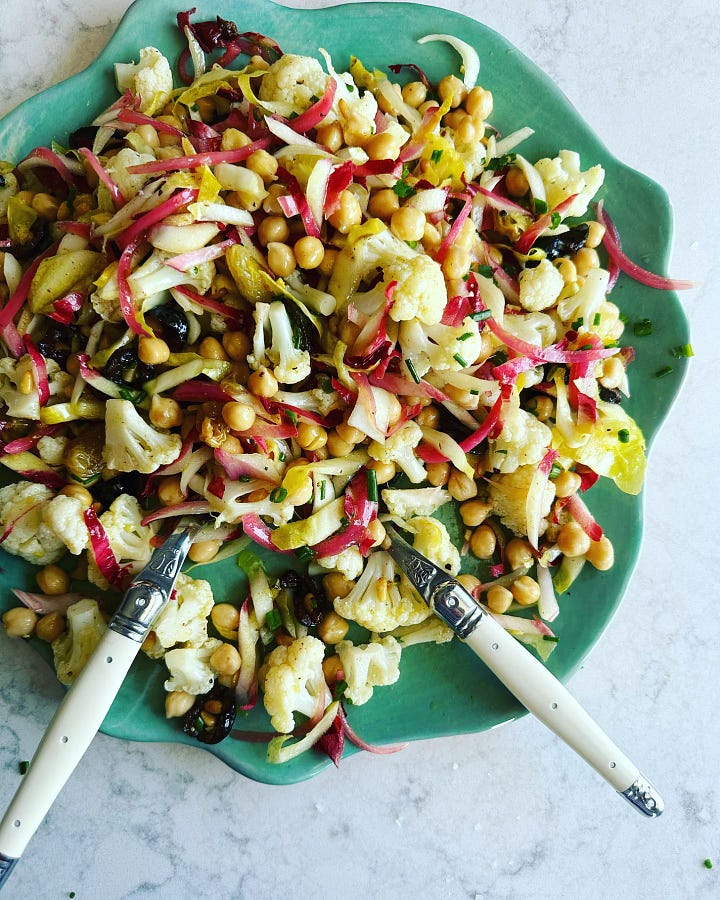
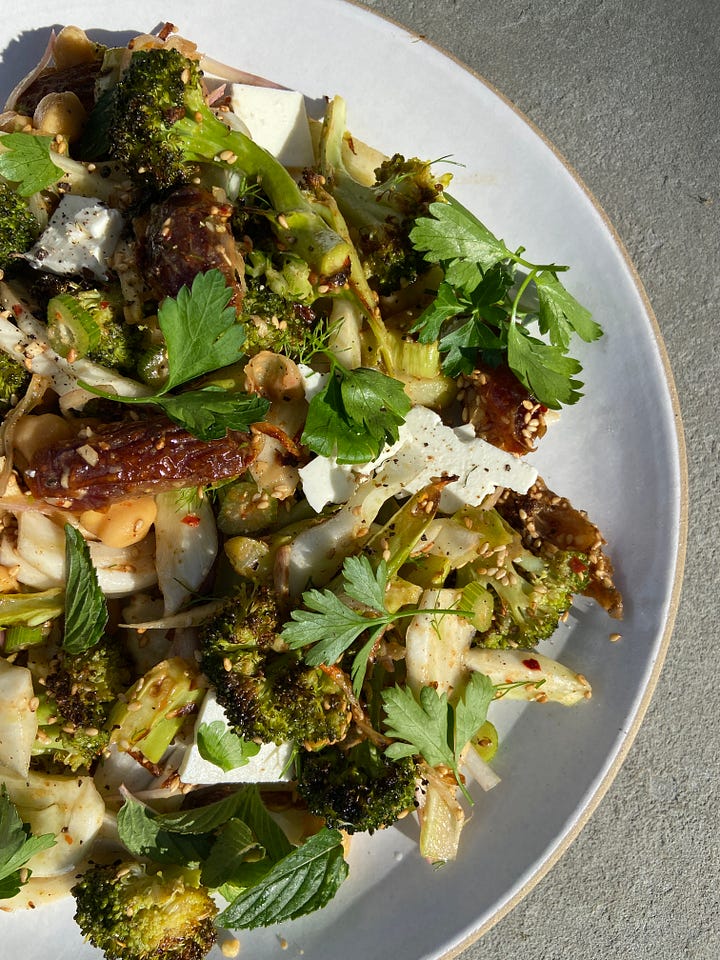
1. What is each ingredient doing here?
Zoom out and consider what each ingredient is contributing using basic categories and adjectives. If you don’t know, move to step 2 or reference my list of 40 ingredients and “All the Staples” in I Dream of Dinner (page 384), which are both organized by ingredients’ attributes, or the Sources of salt, fat, acid, and heat sections in Samin Nosrat’s book, Salt, Fat, Acid, Heat.
Chickpeas: Protein, starch, mild
Cauliflower: Vegetable, brassica, mild, a little sweet
Distilled white vinegar: Acid
Toasted pine nuts: crunch, toasty, nutty
Salt: salt…
White and red Belgian endive: bitter, leafy, juicy
Oil-cured olives: briny, salty
Quick-pickled onion: acidic, oniony hit
Wine-steeped golden raisins: soft, sweet, chew
Minced chives: oniony, herby
Fried parsley leaves: herby, crisp
Madras curry powder: spicy, spiced, anise-y, gingery, garlicky
Champagne vinegar: acid
Canola oil: fat
Minced garlic: garlicky spicy
2. What ingredients do I have that also do those things?
If you don’t know, Google “substitutes for [ingredient].” Someone has definitely wondered the same and asked the internet. You don’t need to do a 1-for-1 substitution for every ingredient—you don’t need to do anything, it’s your kitchen, your rules.
Let’s substitute the original recipe’s ingredients with some of my 40 forevers:
Chickpeas: Instead of 2 cups homemade, use one 15-ounce can, which is 1 ½ cups. Emily notes, if you’re going to use canned, to season them with salt, pepper, and red wine vinegar.
Cauliflower: Broccoli, cauliflower’s green twin
Distilled white vinegar: To me, Sherry vinegar is the best vinegar to do what all the other vinegars do, so I’ll use that here.
Pine nuts: Toasted sesame seeds are a less chompy crunch, but could do the job.
Salt: Thank goodness I have salt.
White and red Belgian endive: Fennel is similarly juicy, crunchy, and bitter.
Oil-cured olives: Feta
Quick-pickled onion: Quick-pickled shallots
Wine-steeped golden raisins: Dates macerated in another acid (the vinegar we’re already using)
Minced chives: Skip, we’ll hit oniony and herby elsewhere.
Fried parsley leaves: Any soft herb (mint, parsley, dill). Frying herbs isn’t that annoying, but if you leave them raw, this salad will keep very well.
Madras curry powder: red pepper flakes, fresh ginger, fresh garlic, ground cumin, Dijon mustard, and we already have fennel in the mix.
Champagne vinegar: Sherry vinegar since we’re already using it
Canola oil: Extra-virgin olive oil
Minced garlic: Got it!
Funny enough, Emily featured a different broccoli + date salad of mine here.
3. How do the steps transform these ingredients?
Now we have a heap of ingredients, but how are we cooking with them? Every step is some combination of heat and time—high or low, dry or wet, quick or slow—to create a specific texture.
It’s helpful to think of cooking in these very rudimentary terms instead of specific techniques because many are working towards the same goal. For example, stir-frying, broiling, grilling, and searing are all examples of high, dry, quick cooking methods, so if a recipe calls for broiling something, chances are it could also be grilled.
Step 2 (blanching cauliflower): High, wet, quick heat for tenderness.
Step 3 (toasting pine nuts): High, dry, quick heat for browning and toastiness.
Steps 4, 5, 6 (cutting endives and mixing): No heat for juicy raw vegetables and combining.
Wine-Steeped Golden Raisins sub-recipe: High, wet, quick-then-slow heat for tenderness.
Pickled Red Onions sub-recipe: High, wet, quick-then-slow heat for tenderness.
Curry Vinaigrette sub-recipe: Toasting the curry powder—low, dry, quick heat for toastiness. Mixing the dressing—no heat for combining.
Chickpeas: Low, wet, slow heat for tenderness.
4. Can any processes be combined?
Look for overlap in processes, results of processes, and ingredients, then consider whether any of those steps and ingredients could be combined. At the most elementary level, the purpose of each of the 15 steps in Keller’s recipe is either tenderness, toastiness, or combining. (LOL.)
The contrast of flavors (acidic, sweet, spicy, toasty) and textures (soft, crunchy, crispy, juicy) is what makes food exciting to eat, so here’s one way we can carry out fewer separate processes without losing that bounty of flavor and texture. Macerating shallots and chickpeas in dressing is simply not the same as quick-pickling red onions for 24 hours, soaking and simmering dried chickpeas, and making a dressing, but the sentiment will be similar enough.

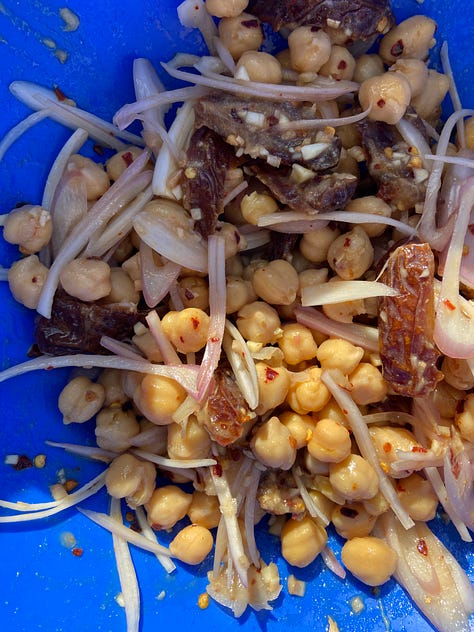
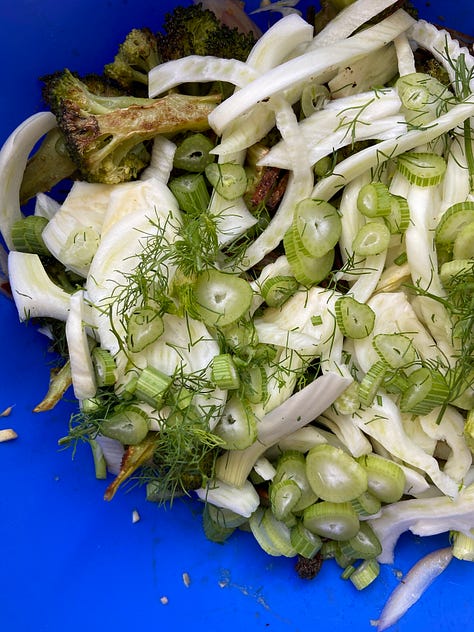
1. Coat broccoli and shallots in ground cumin and roast.
The broccoli is still getting tender but switching it from a wet to a dry cooking method creates some browning to make up for the lack of toasted pine nuts. That’s why half the shallot is there too. We’re also toasting the ground spice, like the curry powder in the Curry Vinaigrette sub-recipe, but all of this is happening at once.
2. Meanwhile, make a dressing and add shallots, dates, and chickpeas.
The through-lines here are wet cooking methods, tenderness, and acid. The other half of shallots will “quick pickle” and the dates and chickpeas will soften in the dressing’s vinegar.
3. Toss everything together.
There’s no one way to adapt a recipe. If you did this exercise, it’s unlikely you’d land at the same place as me. There’s also no guarantee that what you create, never before made just like this, will come out, but the more we try, the more we learn and get better for next time. Just don’t blame any of us if you don’t like the result.
Close-Enough Broccoli-Chickpea Salad
Very adapted from Emily Nunn’s slightly adapted recipe for Curried Cauliflower-Chickpea Salad from Ad Hoc at Home by Thomas Keller
Serves 4 to 6
1 pound broccoli
2 shallots
6 tablespoons extra-virgin olive oil
1 1/2 teaspoon ground cumin
Salt and pepper
1 (14-ounce) can chickpeas (or 1 ½ cups cooked homemade)
2 tablespoons Sherry vinegar, plus more as needed
2 teaspoons Dijon mustard
3/4 teaspoon red pepper flakes
1 inch fresh ginger
1 garlic clove
4 Medjool dates
1 fennel bulb
2 ounces feta
½ cup soft herb leaves, such as parsley, mint, basil, and/or dill
3 tablespoons toasted sesame seeds
1. Heat the oven to 425°F. Cut 1 pound broccoli into florets and cut the stem into bite-size pieces. Thinly slice 2 shallots. Transfer the broccoli and half—just half!—the shallots to a sheet pan and toss with 3 tablespoons olive oil, 1 1/2 teaspoons ground cumin, salt, and pepper. Spread into an even layer and roast until golden-brown and tender, 15 to 20 minutes.
2. Meanwhile, transfer 1 (15-ounce) can chickpeas (or 1 ½ cups cooked homemade) to a colander set in the sink. Add the remaining sliced shallots to the chickpeas and rinse under cold water. Leave in the sink to drain.
3. In a large bowl, stir together 2 tablespoons Sherry vinegar, 2 teaspoons Dijon mustard, and 3/4 teaspoon red pepper flakes. Coarsely chop 1 inch fresh ginger (no need to peel) and 1 garlic clove. Pit 4 Medjool dates and quarter lengthwise. Transfer the ginger, garlic, dates, chickpeas, and shallots to the large bowl. Season with salt and stir to combine.
4. When the broccoli is done, trim the bottom of 1 fennel bulb and discard, then separate the stalks and fronds—reserve these. Quarter the fennel and cut out the core from each. Thinly slice the quarters lengthwise, then thinly slice the stalks and fronds. Add the fennel, roasted broccoli and shallots, and 3 tablespoons olive oil to the bowl and stir to combine. Crumble in 2 ounces feta and add ½ cup soft herb leaves, such as parsley, mint, basil, and/or dill and 3 tablespoons toasted sesame seeds. Stir to combine. Season to taste with salt and vinegar (if bland) and black pepper and red pepper flakes (if sweet).
PRINT THE RECIPE
SWAPS
Broccoli: Any tender roasted vegetable, like cauliflower, Brussels sprouts, carrots, or parsnips. Sear asparagus or snap peas in the springtime.
Shallots: Thinly sliced scallions or red onion
Ground cumin: Madras curry powder, garam masala, ground coriander
Chickpeas: Cooked green or black lentils, toasted walnuts, seared tofu
Ginger and garlic: Use ½ teaspoon of their ground versions, or use one or the other
Dates: Raisins, dried cherries or cranberries, toasted coconut chips, pomegranate seeds
Sherry vinegar: Lemon juice, white wine or rice vinegar
Dijon mustard: Ground or whole-grain mustard, or omit
Red pepper flakes: Something spicy—chopped fresh chile, hot sauce, or a small amount of cayenne
Fennel: Something juicy and bitter, like radicchio, endive, arugula, escarole, or Savoy cabbage. Or skip it and load up on herbs.
Feta: Something briny like olives, capers, anchovies, or pepperoncini peppers
Soft herbs: An assertive, soft green like arugula or watercress.
Toasted sesame seeds: Any kind of toasted nut, like cashews or almonds, or seed, like sunflower or pepitas.
THINGS TO ADD
Add more protein with quinoa or leftover pulled chicken.
Pile the last of the salad into a pita with lemony tahini sauce or zhoug (also instead of the Sherry-mustard vinaigrette, you could probably use tahini sauce or zhoug).
The salad could accept more juicy-crunch, like thinly sliced cucumbers, celery, or radishes.
OTHER NOTES
Leftovers: Keeps for 3 days in the fridge. Refresh with more salt, vinegar, and olive oil.
Vegan: Trade out the feta for one of the subs above.
Editing and recipe testing: Caroline Lange
Brand design: Linda Huang

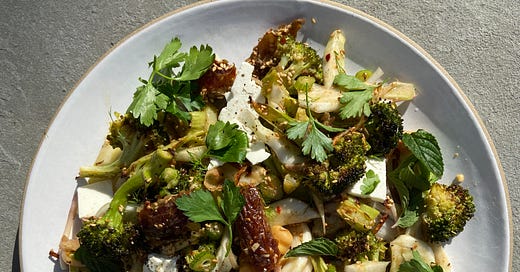


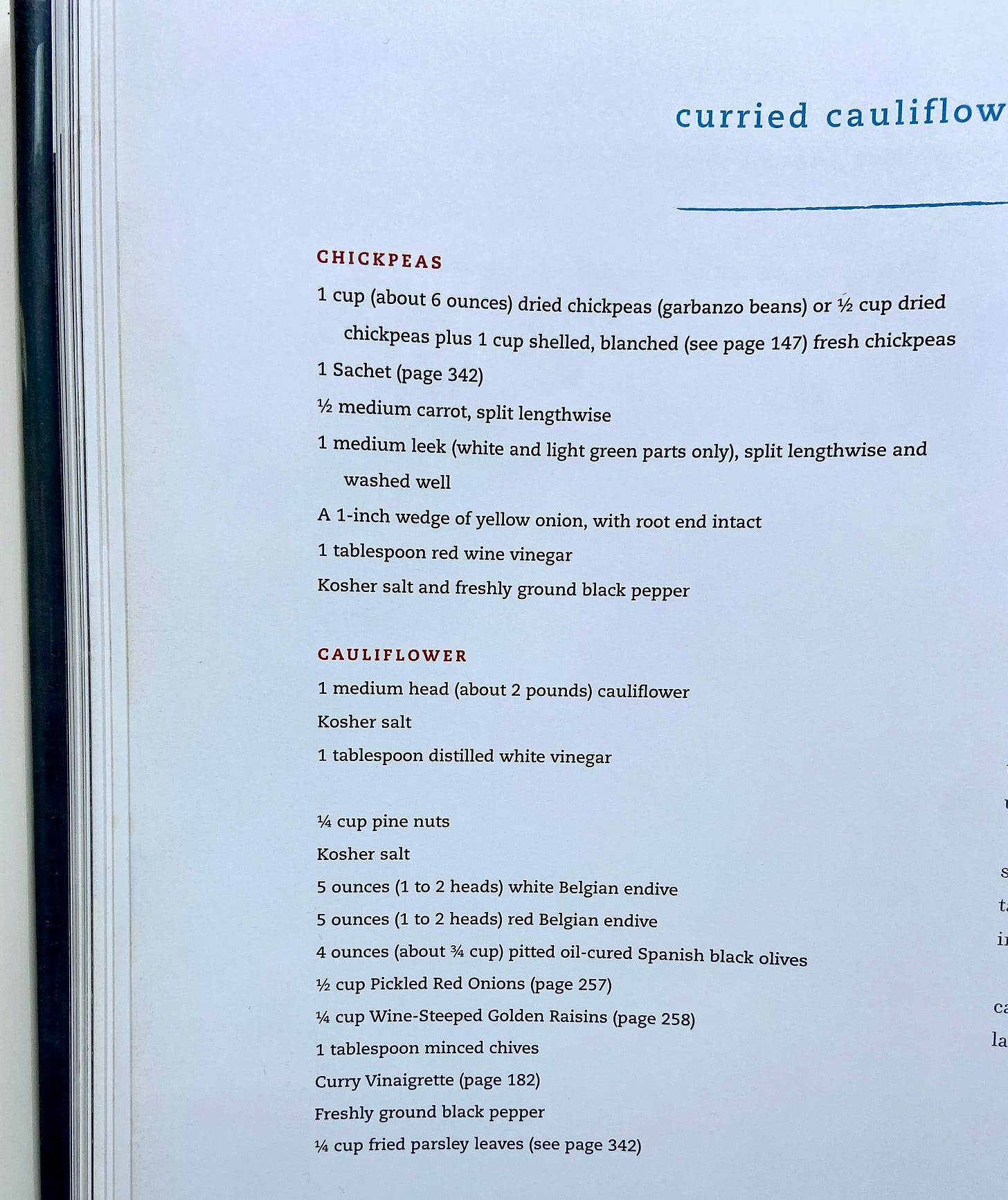



I chuckled at “is it worth it? I won’t make it, so I’ll never know”. Knowing your limits is half the battle! 😂
I just made this and it is delicious. Great vegetarian meal. Thank you.